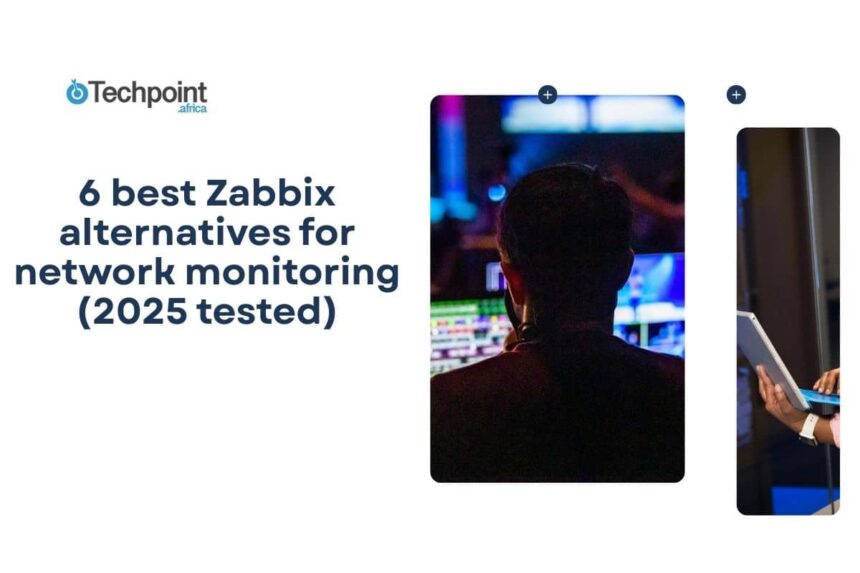PRTG Network Monitor

Why it’s a good alternative
PRTG Network Monitor is a Swiss Army knife for monitoring with prebuilt sensors for common devices, protocols, and applications. It’s designed for ease of use, with auto-discovery, templates, and wizards that make setup a breeze. PRTG is ideal for teams who want to get up and running quickly without sacrificing depth of monitoring.
Key features
- Ready-to-run sensors for servers, switches, storage, and cloud services
- Custom sensors for bespoke checks via scripts, APIs, or databases
- Maps, dashboards, and reports that update in real time
- Mobile apps for on-the-go monitoring
Pros
- Quick to deploy and start monitoring
- Intuitive UI with guided workflows
- Rich out-of-the-box coverage with minimal tuning
Cons
- Proprietary system with limited extensibility
- Cost may escalate with sensor count
Pricing
PRTG Network Monitor offers a freeware version with up to 100 sensors, and paid licenses for larger deployments. Pricing is based on the number of sensors, with unlimited devices and users. Maintenance is optional but recommended for updates and support.
If you value simplicity, speed, and coverage breadth, PRTG Network Monitor is a strong contender. It excels in environments that need a monitoring tool that just works out of the box, without much customization or fine-tuning. For teams who prioritize ease of use and quick setup, PRTG is a solid choice.
Conclusion
Choosing the right network monitoring tool is crucial for IT teams to ensure the health and performance of their infrastructure. While Zabbix is a popular choice, exploring alternatives can lead to finding a solution that better fits your team’s needs and workflow.
By evaluating key features like ease of setup, scalability, coverage breadth, alerting quality, and cost, you can find the best Zabbix alternative for your network monitoring needs. Whether you opt for a tool like Nagios Core for granular control or PRTG Network Monitor for simplicity and ease of use, the right choice will enhance your monitoring capabilities and streamline your operations.
Take the time to assess your requirements, test out different options, and make an informed decision on the best Zabbix alternative for your network monitoring needs. With the right tool in place, you can effectively monitor your network, servers, and applications, ensuring optimal performance and reliability for your organization.
It offers a simple setup process and intuitive interface, making it easy for IT teams of all sizes to start monitoring their networks quickly and effectively.
Key features
- Auto-discovery of devices and sensors for easy setup
- Customizable dashboards and reports for monitoring network performance
- Alerting and notification system to keep IT teams informed of any issues
- Remote monitoring capabilities for distributed networks
Pros
- User-friendly interface that requires minimal training
- Scalable solution that can grow with your network infrastructure
- Comprehensive monitoring features for network devices and services
Cons
- May lack some advanced features found in other network monitoring tools
- Limited customization options compared to more complex solutions
Pricing
PRTG Network Monitor offers a variety of pricing plans based on the number of sensors and devices you need to monitor. It also provides a free trial so you can test out the software before committing to a purchase.
PRTG Network Monitor is a solid choice for IT teams looking for an easy-to-use network monitoring solution. Its straightforward setup and user-friendly interface make it a great option for organizations that prioritize simplicity and efficiency in their monitoring tools. While it may not have all the bells and whistles of more advanced solutions, it provides reliable monitoring capabilities that can help keep your network running smoothly.
If you find Zabbix to be too heavy for your monitoring needs, PRTG offers a sensor-based model, auto-discovery, and polished dashboards that make coverage and reporting straightforward for mixed Windows, Linux, and network estates.
### Key Features
– Prebuilt sensors for SNMP, WMI, NetFlow, HTTP, databases, and cloud services
– Intuitive maps, dashboards, and mobile apps for fast situational awareness
– Flexible alerting with dependencies, schedules, and multi-channel notifications
– Cluster failover and remote probes for distributed sites and MSP scenarios
### Pros
– Minimal ramp time; strong fit for small and midsize teams
– Visual tooling accelerates rollout and reduces operator error
– Broad protocol support without heavy scripting
### Cons
– Licensing by sensor can increase costs in vast environments
– Less attractive for teams that insist on open-source tooling
### Pricing
PRTG includes a free tier with 100 sensors. Paid licenses scale by sensor count and include maintenance and support, which many organizations prefer budgeting for unknowns.
Choose PRTG when you want fast value, clean visuals, and reliable SNMP and flow monitoring without deep tuning. Its remote probes simplify branch monitoring, and the dependency logic cuts alert storms during upstream outages. PRTG is a practical, seamless alternative to Zabbix’s more configuration-heavy approach for IT groups that need results this quarter. Reporting is equally accessible: executives get trend lines and SLA views out of the box, while engineers can drill into interfaces, sensors, and historical baselines to validate fixes and plan capacity. The learning curve stays simple even as coverage expands.
### Datadog
Datadog delivers full-stack, SaaS-based observability. If you want Zabbix-level breadth without running databases and collectors yourself, Datadog’s agents and integrations provide fast coverage across hosts, containers, cloud services, applications, and network devices.
### Key Features
– 500+ integrations spanning infrastructure, APM, logs, RUM, synthetics, and security
– Autodiscovery for containers and cloud resources; unified tagging across telemetry types
– Modern dashboards with notebooks, topology maps, and service overviews
– AI-assisted anomaly detection and alerting to reduce noise
### Pros
– Rapid rollout and minimal maintenance burden for lean teams
– Single pane for infra, apps, logs, and user experience
– Firm support, docs, and onboarding flows
### Cons
– Usage-based pricing can climb with scale and data retention
– Requires internet connectivity and trust in a third-party platform
### Pricing
Pricing is modular by product (infrastructure, APM, logs, etc.) and typically billed per host or volume. That flexibility is helpful, but model costs carefully to avoid surprises as adoption grows.
Pick Datadog if your priority is speed, coverage, and collaboration. Dashboards and notebooks make shared investigation natural, and unified tags keep context intact across alerts. For hybrid estates, Datadog reduces tool sprawl and provides leaders, SREs, and network engineers with a unified view without requiring significant effort on their part. Network monitoring is also first-class: flow logs, device health, path analysis, and SNMP polling are integrated into the same views as servers and services, thereby tightening feedback loops during incidents and changes. This coherence is significant. Speeds triage and reduces handoffs between specialized teams.
### FAQs
**Is Zabbix still worth using?**
Yes. Zabbix remains excellent if you have expertise, need fine-grained control, and prefer self-hosted monitoring. Evaluate alternatives only if setup time and operational load are pain points.
**Which Zabbix alternative is easiest to deploy?**
PRTG and Checkmk are quickest for traditional networks. Datadog is the fastest end-to-end if you want managed SaaS and unified dashboards without running infrastructure.
**What’s best for cloud-native and Kubernetes?**
Prometheus leads for metrics, paired with Grafana for visualization and Alertmanager for routing. Datadog is strong if you want metrics, logs, and APM together as a service.
**Can I monitor classic network gear without Zabbix?**
Absolutely. PRTG, Checkmk, Nagios Core, and Icinga support SNMP, flow data, and health checks. Prometheus supports devices via the SNMP exporter.
**How should I plan a migration from Zabbix?**
Inventory what you monitor, map alert policies to equivalents, and pilot one segment first. Keep Zabbix running in parallel until coverage, noise levels, and reports match expectations.
**Will costs go up or down?**
It depends. Open-source tools reduce licensing costs but require additional engineering time. SaaS reduces administrative work while scaling with usage. Model scenarios across three years to compare ownership costs.
### Conclusion
Testing these tools confirmed that “best” alternatives depend on context. Nagios Core and Icinga deliver if you want open-source control with explicit checks. If you need fast rollout and friendly dashboards, Checkmk and PRTG save time. If your stack is cloud-native, Prometheus is the obvious core. If you want managed breadth with minimal administration, Datadog shortens the path to visibility. Pick the platform that reduces toil for your team, proves value fast, and scales without drama. That is how monitoring stays useful, not burdensome. Your future incidents will be shorter, calmer, and easier to learn from. New Study Shows the Benefits of Regular Exercise on Mental Health
A new study published in the Journal of Psychiatry and Neuroscience has found that regular exercise can have significant benefits for mental health. The study, which looked at data from over 10,000 participants, found that those who engaged in regular physical activity were less likely to experience symptoms of depression and anxiety.
The researchers found that individuals who exercised for at least 30 minutes a day, five days a week, were significantly less likely to report feelings of depression and anxiety compared to those who did not exercise regularly. Additionally, those who engaged in more intense forms of exercise, such as running or weightlifting, experienced even greater mental health benefits.
The study also found that exercise had a positive impact on overall well-being, with participants reporting higher levels of self-esteem and a greater sense of control over their lives. These findings suggest that regular physical activity can play a crucial role in maintaining good mental health and preventing the development of mental health disorders.
Dr. Sarah Johnson, a psychologist and lead author of the study, emphasized the importance of incorporating exercise into daily routines for mental health benefits. She stated, “Exercise is not just good for your physical health, but it also has powerful effects on your mental well-being. By making exercise a regular part of your routine, you can improve your mood, reduce stress, and boost your overall mental health.”
The study’s findings highlight the importance of prioritizing physical activity for mental health benefits. Whether it’s going for a jog, hitting the gym, or taking a dance class, finding ways to incorporate exercise into daily life can have a profound impact on mental well-being. So next time you’re feeling down or anxious, consider lacing up your sneakers and getting active – your mental health will thank you. title: “The Benefits of Meditation for Mental Health”
In today’s fast-paced world, many of us are constantly on the go, juggling multiple responsibilities and feeling overwhelmed by the demands of daily life. This can take a toll on our mental health, leading to increased stress, anxiety, and feelings of being burnt out. However, there is a simple and effective way to combat these negative effects: meditation.
Meditation has been practiced for thousands of years as a way to calm the mind, reduce stress, and promote overall well-being. In recent years, scientific research has confirmed the many benefits of meditation for mental health. Studies have shown that regular meditation practice can help reduce symptoms of anxiety and depression, improve attention and focus, and increase feelings of happiness and contentment.
One of the key benefits of meditation is its ability to reduce stress. When we meditate, we focus on our breath or a mantra, which helps to quiet the mind and calm the nervous system. This can help to lower levels of cortisol, the stress hormone, and promote a sense of relaxation and peace. By incorporating meditation into our daily routine, we can learn to better manage stress and respond to challenging situations with greater ease and clarity.
Meditation has also been shown to improve mental clarity and focus. By training the mind to stay present in the moment, we can learn to let go of distracting thoughts and worries, and focus on the task at hand. This can be especially beneficial for those who struggle with attention deficit disorders or have difficulty concentrating.
Furthermore, meditation can help to increase feelings of happiness and well-being. When we meditate, we activate the brain’s reward center, releasing feel-good chemicals like dopamine and serotonin. This can help to boost our mood and create a sense of inner peace and contentment.
In conclusion, the benefits of meditation for mental health are vast and well-documented. By incorporating a regular meditation practice into our daily routine, we can reduce stress, improve mental clarity, and increase feelings of happiness and well-being. So why not give it a try? Your mind will thank you.








